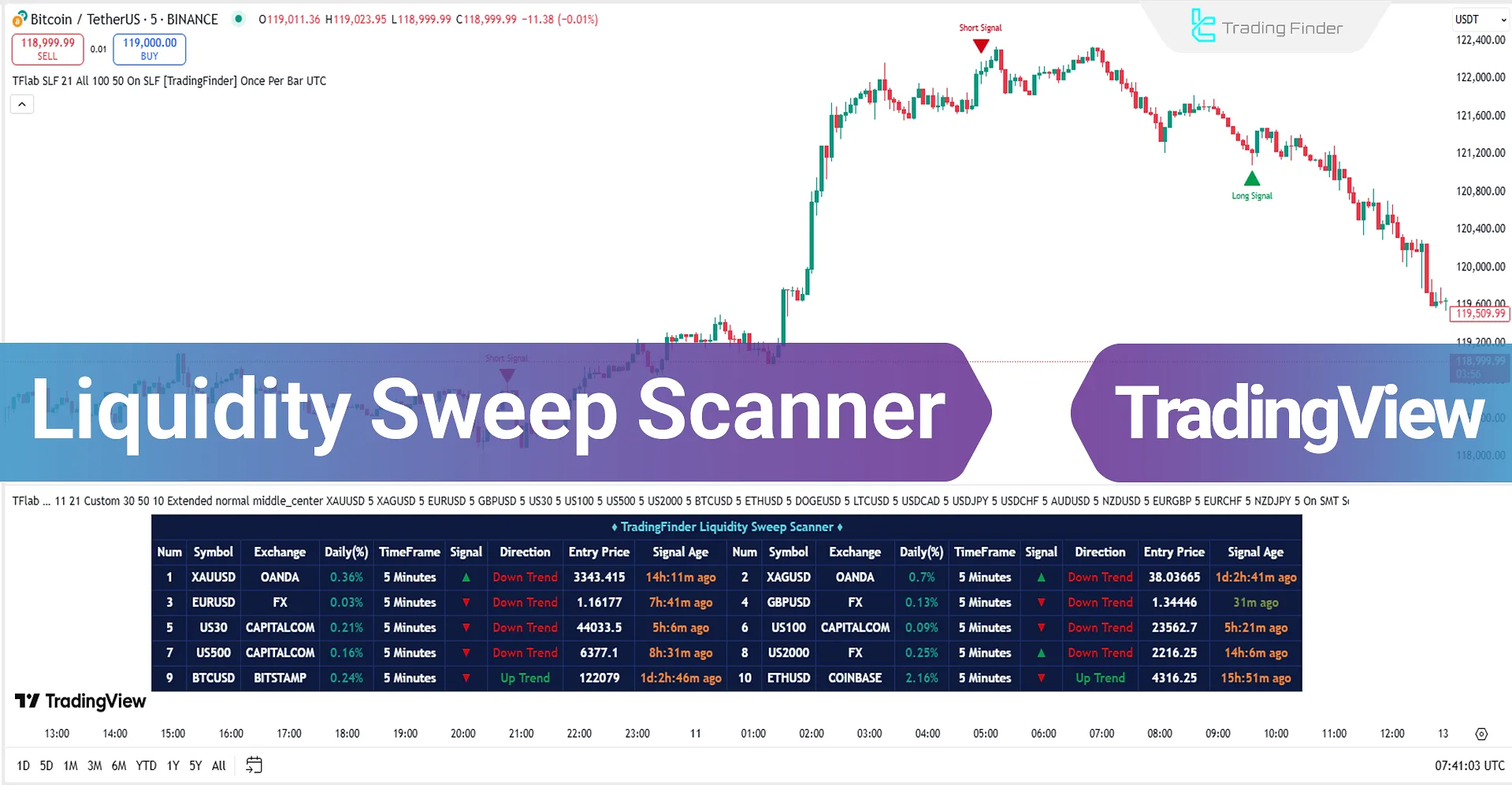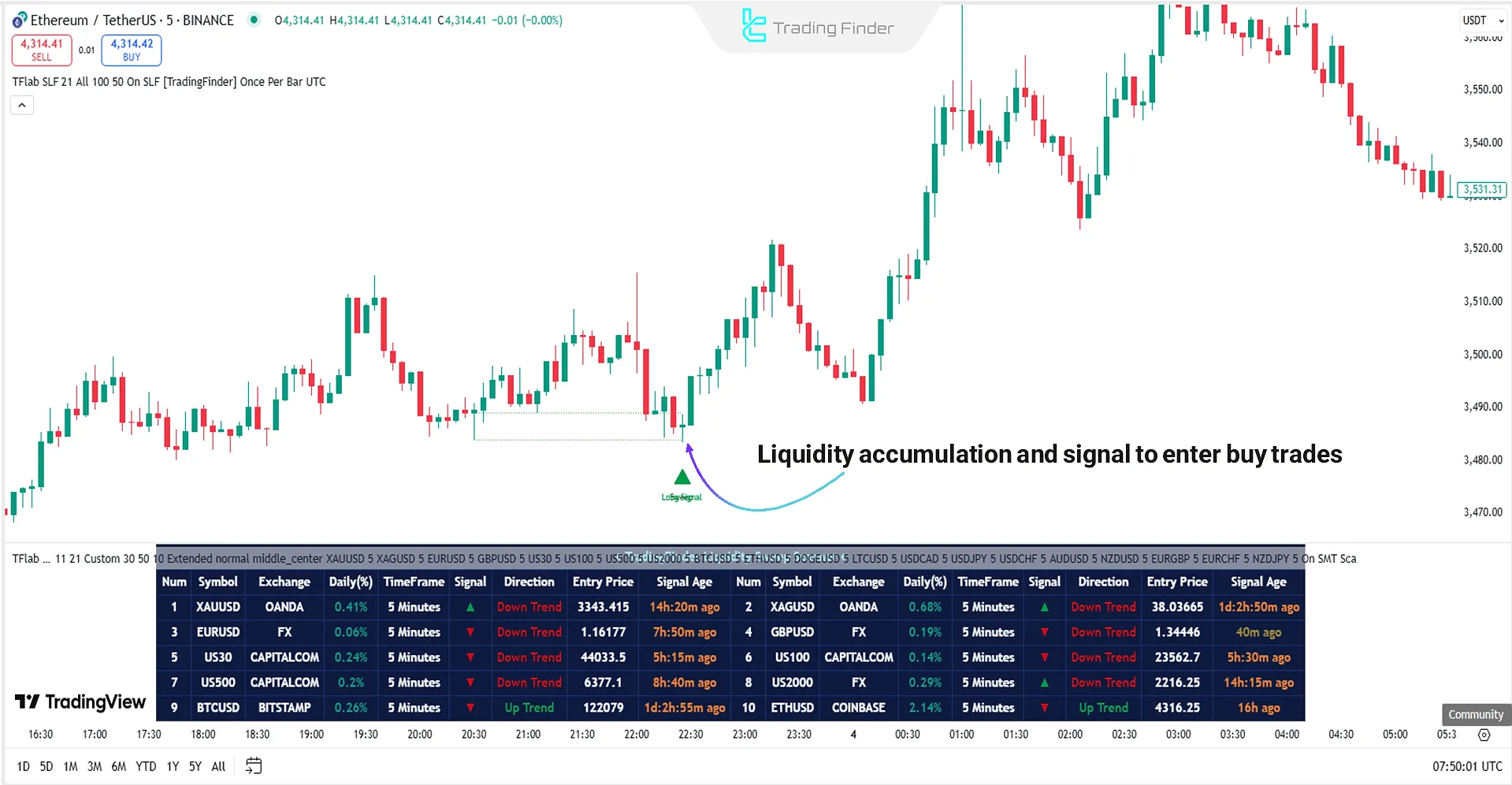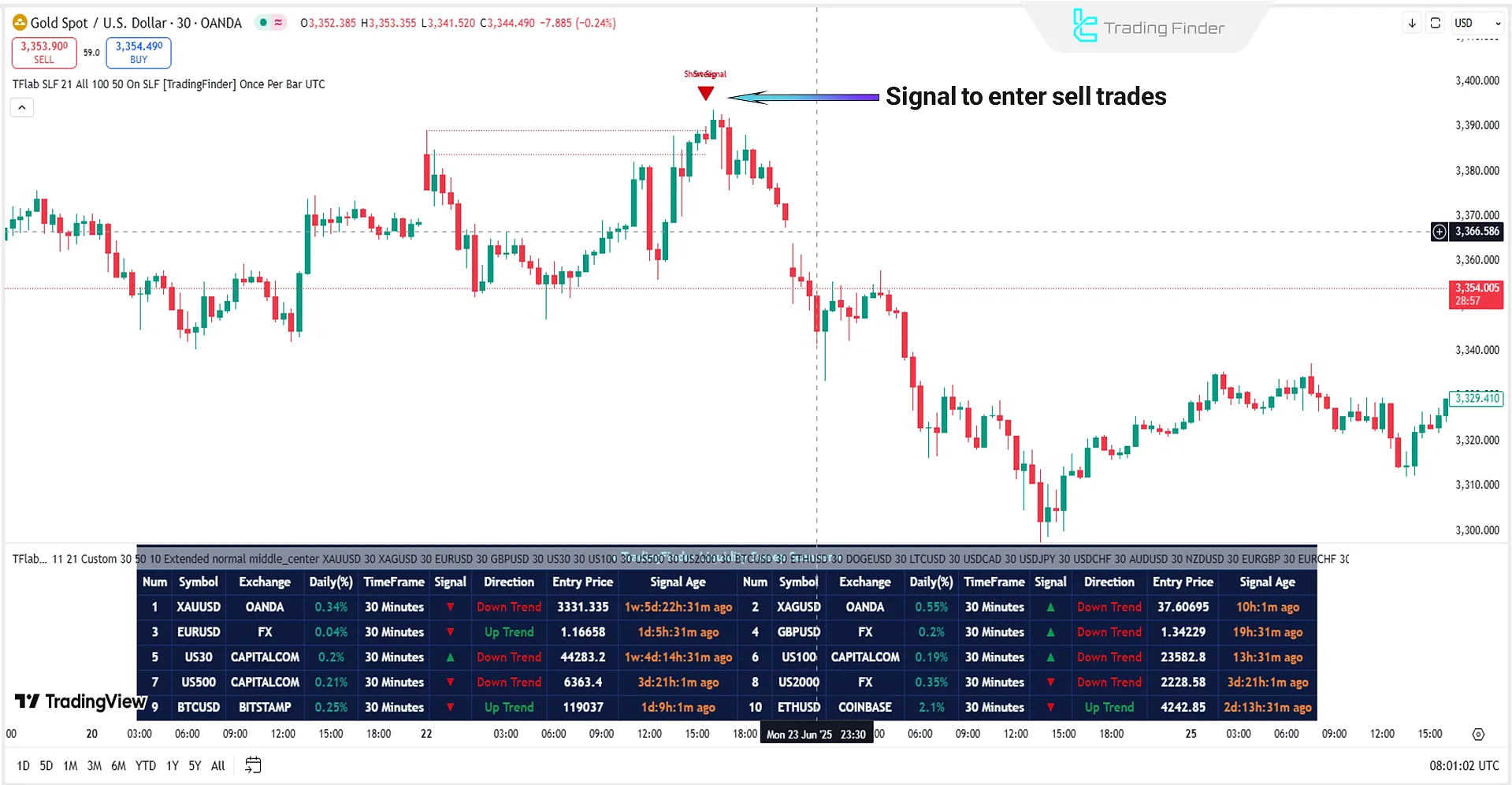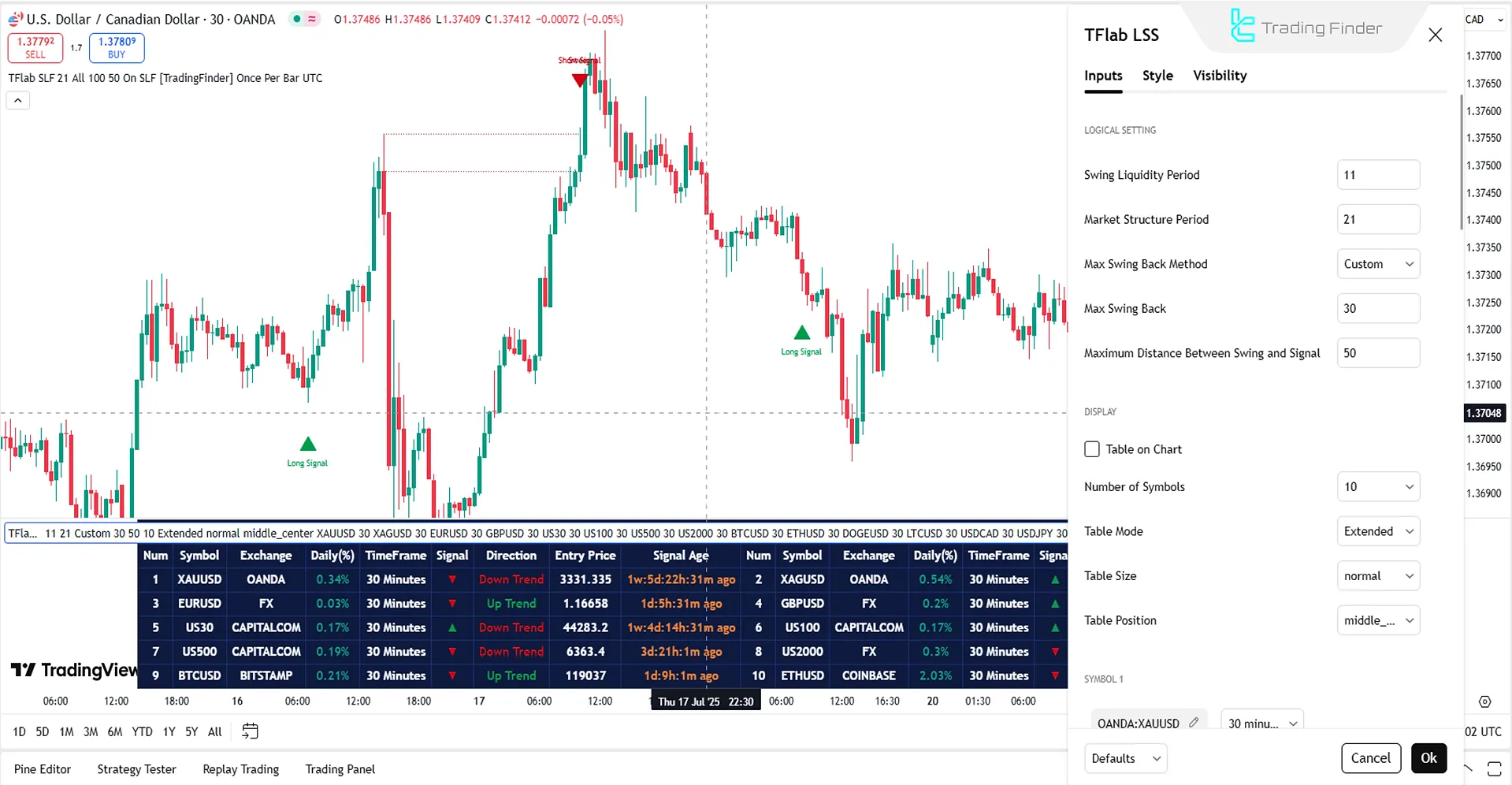TradingView
MetaTrader4
MetaTrader5
The Liquidity Hunt Scanner is an advanced tool in price action analysis that identifies high-probability price reversal zones by analyzing "Liquidity Sweep" and price reactions at key structural levels.
In addition to filtering market noise, this scanner identifies targeted liquidity collection points and areas prone to reversal or trend continuation.
 Liquidity Sweep Scanner in TradingView
Liquidity Sweep Scanner in TradingView
The Liquidity Hunt Scanner, besides displaying buy and sell signals as green and red arrows, provides a box showing real-time data of multiple trading symbols. Information displayed in this box includes:
- Price change percentage
- Selected time frame
- Trend direction
- Current price
- Time elapsed since the last signal was issued
Note: Access to this scanner is available for $50. After payment, contact Trading Finder support via website live chat, Telegram, or WhatsApp to receive the activation link.
Liquidity Sweep Scanner Specifications Table
General features of the Liquidity Sweep Scanner are shown in the table below:
Indicator Categories: | ICT Tradingview Indicators Smart Money Tradingview Indicators Liquidity Tradingview Indicators |
Platforms: | Trading View Indicators |
Trading Skills: | Advanced |
Indicator Types: | Reversal Tradingview Indicators |
Timeframe: | Multi-Timeframe Tradingview Indicators |
Trading Style: | Intraday Tradingview Indicators |
Trading Instruments: | TradingView Indicators in the Forex Market Cryptocurrency Tradingview Indicators Stock Tradingview Indicators Commodity Tradingview Indicators Indices Tradingview Indicators Share Stocks Tradingview Indicators |
Liquidity Sweep Scanner at a Glance
Liquidity Sweep Scanner works based on three key components, each playing an essential role in identifying high-probability reversal zones:
Identifying Swing Points
First, valid market highs (Swing Highs) and lows (Swing Lows) are identified.
These points are usually liquidity accumulation zones and the location of many traders' stop-losses, making them highly important in market decision-making.
Defining the Reaction Zone
This is the area between the swing point and the highest or lowest open/close price of the candle.
It is typically where the price reacts again after an initial breakout and often determines the next market direction.
Checking for Liquidity Sweep
This stage assesses price returning to the reaction zone and breaking past the Swing level.
Such a break may be a genuine breakout or merely a liquidity sweep; distinguishing between the two is key to filtering false breakouts.
Identifying the Confirmation Candle
Special candles like Dojis or small-bodied patterns within the reaction zone usually indicate a failed breakout and a high probability of a trend reversal.
Scanner Behavior in an Uptrend
In an uptrend scenario, the Liquidity Hunt Scanner first identifies a valid Swing Low and marks the reaction zone from the low point to the lowest open/close price of the candle.
Then, the price returns to this zone, creating a Liquidity Sweep as a price correction.
A confirmation candle, such as a Doji or small-bodied candle, in this area signals a false breakout and seller weakness. In such cases, a green arrow appears to signal buy entries.

Scanner Behavior in a Downtrend
In a downtrend, the scanner identifies a valid Swing High where buyers' liquidity is concentrated and marks the reaction zone from the high to the highest open/close price of the candle.
A price return to this zone, along with a short-term break above the high but failure to hold, signals buyer weakness.
When a confirmation candle, such as a Doji or bearish candle, closes in this zone, a red arrow appears to signal sell entries.

Liquidity Sweep Scanner Settings
Image below shows an overview of the Liquidity Sweep Scanner settings:

Logical Settings
- Swing Liquidity Period: Period for detecting swing liquidity
- Market Structure Period: Period for displaying the market structure
- Max Swing Back Method: Maximum swing-back method
- Max Swing Back: Maximum number of swing backs
- Maximum Distance Between Swing and Signal: Maximum distance between the swing point and the signal
Display
- Table on Chart: Show table on chart
- Number of Symbols: Number of symbols displayed
- Table Mode: Table display mode
- Table Size: Select table size
- Table Position: Table position on the chart
Symbol
- Symbol 1–20: Select up to 20 trading symbols in settings
Alert
- Alert: Show alerts
- Alert Name: Selected alert name
- Message Frequency: Alert message frequency
- Show Alert Time by Time Zone: Show alert time based on time zone
Note: This scanner allows adding up to 20 trading symbols. The user's preferred time frame (same for all symbols) can be selected from the settings.
Conclusion
The Liquidity Sweep Scanner identifies valid Swing Highs and Swing Lows, reaction zones, and key reversal points.
By combining liquidity data, market structure, and confirmation candles, this trading tool filters out false breakouts and identifies low-risk entry opportunities.
Liquidity Sweep Scanner on TradingView PDF
Liquidity Sweep Scanner on TradingView PDF
Click to download Liquidity Sweep Scanner on TradingView PDFIs the Liquidity Sweep Scanner suitable for short-term trading?
Yes. Due to its quick detection of price reactions and sweeps, it is highly effective for scalping and intraday trading.
What is the main advantage of the Liquidity Sweep Scanner?
It focuses on specific zones that simultaneously include liquidity, structural reaction, and candlestick signals. Combining these three factors reduces risk and increases the probability of successful trades.
Hi, could you please customize this indicator to allow adding 5 symbol selections, if possible? there are 10,12,14 etc
Hello, creating a custom indicator is not possible. However, you can use the free indicators and their tutorial videos to configure the settings.
Hi, can you pplease give me acces to the liquidity sweep scanner indicator. thanks in advance.
Hello — please contact our support team on Telegram or WhatsApp so we can grant you free access.





